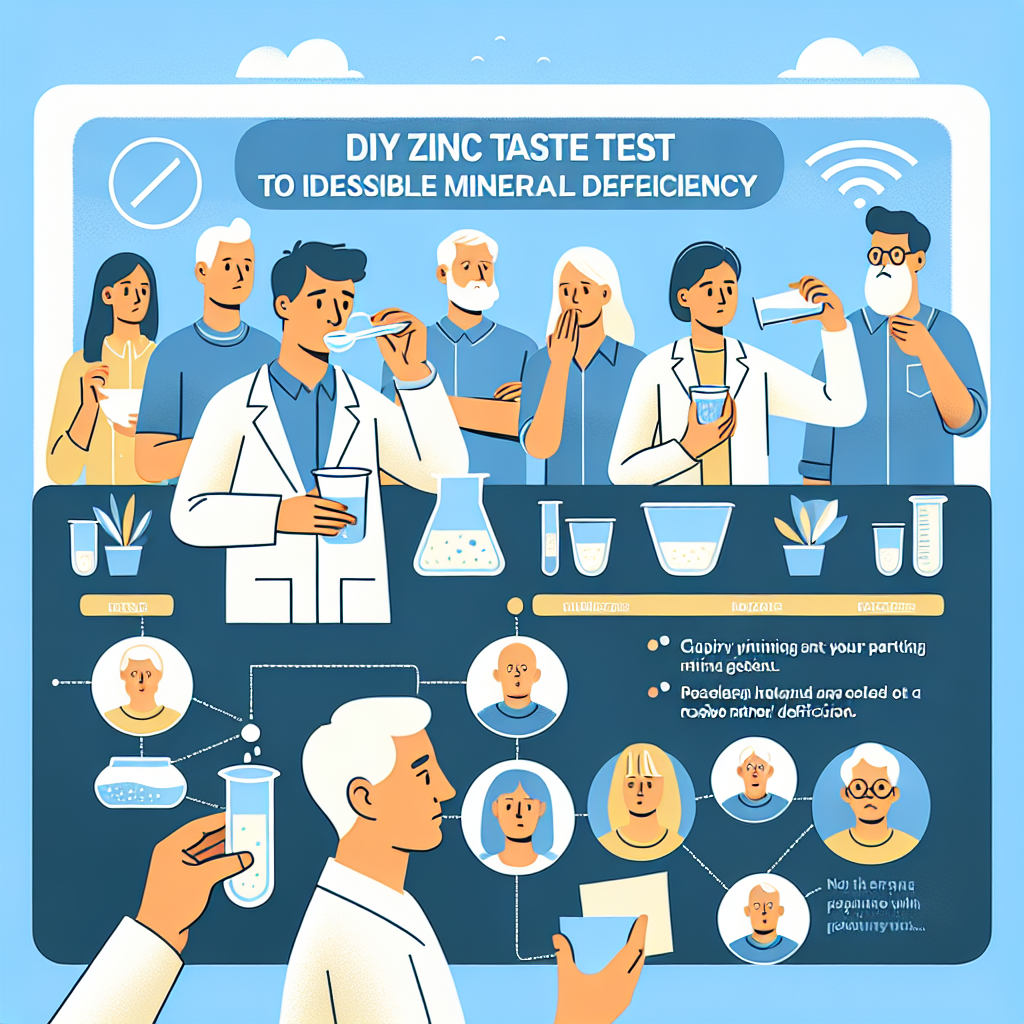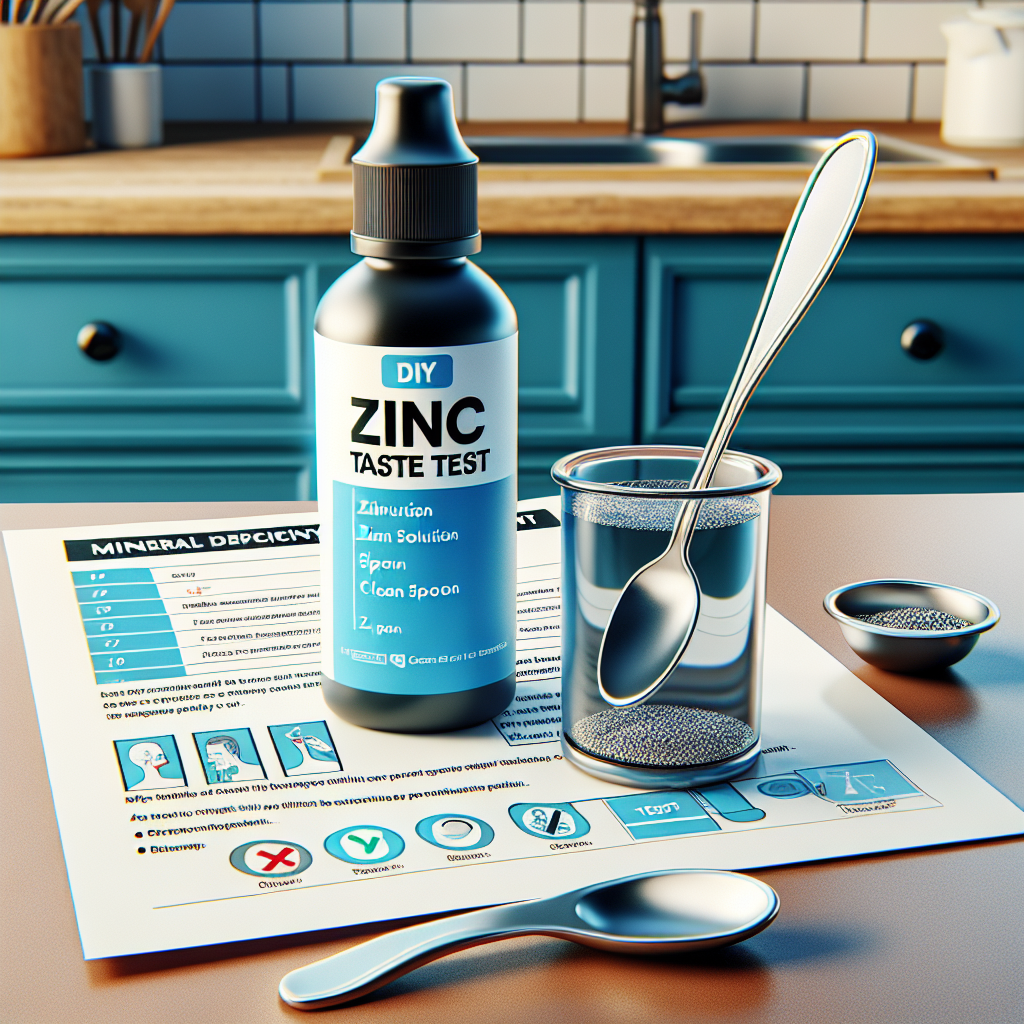Zinc Taste Test: A DIY Way to Gauge Mineral Deficiency

Discover if you’re experiencing a mineral deficiency with a DIY Zinc Taste Test. It’s a simple, at-home method that can provide valuable insights into your health. Don’t wait, take control of your wellbeing today. Visit Vibrant Vitality to learn more.
Understanding the Zinc Taste Test: A DIY Approach to Detecting Mineral Deficiency
Zinc is an essential mineral that plays a crucial role in numerous aspects of our health. It aids in the functioning of our immune system, wound healing, and protein synthesis. Despite its importance, zinc deficiency is a common issue worldwide, often going unnoticed due to its subtle symptoms. However, there is a simple, do-it-yourself method to gauge if you might be deficient in this vital mineral: the zinc taste test.
The zinc taste test is a quick and easy way to assess your body’s zinc levels. It is based on the premise that your ability to taste a solution of zinc sulfate is directly proportional to your body’s zinc status. In other words, the less you can taste the solution, the more likely you are to be deficient in zinc.
To perform the test, you will need a solution of zinc sulfate, which can be purchased online or from a health food store. The test is conducted by placing a small amount of the solution on your tongue. If you immediately taste a strong, unpleasant metallic flavor, it is likely that your zinc levels are adequate. If you taste nothing or only a slight metallic flavor after a few seconds, it could indicate a deficiency.
While the zinc taste test is a convenient tool, it is important to note that it is not a definitive diagnostic method. It is a subjective test, meaning the results can vary based on individual taste sensitivity. Some people naturally have a heightened sense of taste, while others may have a diminished sense due to factors like age or smoking. Therefore, the test should be used as an initial indicator rather than a conclusive diagnosis.
Moreover, the taste test only provides a snapshot of your zinc status at a particular moment. Zinc levels in the body can fluctuate based on dietary intake, stress levels, and other factors. Therefore, even if you pass the taste test, it doesn’t necessarily mean you are getting enough zinc consistently. It’s always a good idea to follow a balanced diet rich in zinc-containing foods like meat, shellfish, legumes, and seeds.
If the zinc taste test indicates a potential deficiency, it is advisable to consult a healthcare professional. They can conduct more accurate tests and provide guidance on how to address the deficiency, if present. This might involve dietary changes, supplementation, or both. It’s important not to self-diagnose and start taking supplements without professional advice, as excessive zinc intake can also have adverse effects.
In conclusion, the zinc taste test is a useful tool for getting a general idea of your body’s zinc status. It’s a simple, DIY approach that can be done at home, providing an initial indication of whether you might be deficient in this important mineral. However, it should not replace professional medical advice or more accurate diagnostic methods. If you suspect a zinc deficiency, it’s always best to consult a healthcare professional. Remember, maintaining a balanced diet rich in essential minerals is key to overall health and wellbeing.
How to Perform a Zinc Taste Test at Home: A Step-by-Step Guide

Zinc is an essential mineral that plays a crucial role in numerous aspects of our health. It aids in the functioning of our immune system, wound healing, and DNA synthesis. Despite its importance, many people are unaware of their zinc levels and whether they are getting enough of this vital nutrient. One simple and effective way to gauge your zinc levels is through a zinc taste test. This do-it-yourself method can be performed at home and can provide a rough estimate of your zinc status.
The zinc taste test is based on the premise that your ability to taste zinc is a reflection of your body’s zinc status. The test involves tasting a solution of zinc sulfate and water. If you can taste the zinc distinctly, it suggests that your body has adequate zinc levels. However, if the solution tastes like plain water, it may indicate a zinc deficiency.
To perform the zinc taste test at home, you will need a zinc sulfate solution, which can be purchased online or from a health food store. The solution typically comes in a small bottle with a dropper for easy administration. It’s important to note that the test should be performed at least one hour after eating or drinking to ensure accurate results.
To begin the test, place about 10 milliliters of the zinc sulfate solution in your mouth. Swish it around for about ten seconds, then pay attention to the taste. If you immediately notice a strong, unpleasant taste, this suggests that your zinc levels are likely adequate. If the solution tastes slightly mineral-like or metallic, it may indicate a mild zinc deficiency. If you don’t taste anything at all, or if the solution tastes like plain water, this could suggest a moderate to severe zinc deficiency.
It’s important to remember that the zinc taste test is not a definitive diagnostic tool. It can provide a rough estimate of your zinc status, but it cannot replace a blood test or professional medical advice. If your zinc taste test suggests a deficiency, it’s crucial to consult with a healthcare provider. They can perform more accurate tests and provide appropriate treatment if necessary.
Zinc deficiency can lead to a variety of health problems, including impaired immune function, slow wound healing, and loss of appetite. Therefore, it’s important to ensure that you’re getting enough of this essential mineral. The zinc taste test is a simple and convenient way to gauge your zinc status at home. However, it should be used as a preliminary screening tool and not as a substitute for professional medical advice.
In conclusion, the zinc taste test is a do-it-yourself method that can provide a rough estimate of your zinc status. It’s easy to perform at home and can be a useful tool in maintaining optimal health. However, it’s important to remember that the test is not a definitive diagnostic tool and should not replace professional medical advice. If you suspect a zinc deficiency, it’s crucial to consult with a healthcare provider for accurate testing and treatment.
The Science Behind the Zinc Taste Test: Uncovering Hidden Mineral Deficiencies
Zinc is an essential mineral that plays a crucial role in numerous aspects of cellular metabolism. It is involved in the function of approximately 300 enzymes and is necessary for the body’s defensive (immune) system to function properly. Despite its importance, zinc deficiency is a common issue worldwide, affecting an estimated 2 billion people. One simple, do-it-yourself method to gauge a potential zinc deficiency is the zinc taste test.
The science behind the zinc taste test is based on the premise that the body’s ability to taste zinc is directly correlated with the body’s zinc status. In other words, if you are deficient in zinc, you will not be able to taste it. Conversely, if your body has sufficient zinc, you will be able to detect its taste. This is because zinc is required for the proper function of taste and smell receptors.
The zinc taste test involves dissolving a small amount of zinc sulfate in water and then tasting the solution. If you can taste the zinc immediately, it is likely that your zinc levels are adequate. If the solution tastes like plain water, it may indicate a zinc deficiency. However, it’s important to note that while this test can provide a general indication of zinc status, it is not a definitive diagnostic tool.
The zinc taste test is a simple and cost-effective way to gauge potential mineral deficiencies. However, it is not without its limitations. For one, the test relies on subjective taste perception, which can vary greatly from person to person. Factors such as age, smoking status, and even the time of day can influence taste perception. Furthermore, the test does not provide a quantitative measure of zinc status. It can only provide a general indication of whether zinc levels are likely to be adequate or deficient.
Despite these limitations, the zinc taste test can be a useful tool in the broader context of assessing nutritional status. It can serve as a preliminary screening tool, prompting individuals who consistently taste no zinc to seek further testing and potentially necessary supplementation.
It’s important to remember that while zinc is an essential mineral, too much can also be harmful. Excessive zinc intake can lead to copper deficiency, impaired immunity, and a range of other health problems. Therefore, it’s crucial to seek professional advice before starting any supplementation regimen.
In conclusion, the zinc taste test is a simple, do-it-yourself method to gauge potential zinc deficiency. While it is not a definitive diagnostic tool, it can serve as a useful preliminary screening tool. If you suspect you may be deficient in zinc, it’s always best to consult with a healthcare professional. They can provide a more accurate diagnosis and guide you on the best course of action to correct any deficiencies.
The science behind the zinc taste test is a fascinating example of how our bodies’ sensory systems can provide insight into our nutritional status. It serves as a reminder of the intricate interplay between our diet, our senses, and our overall health.